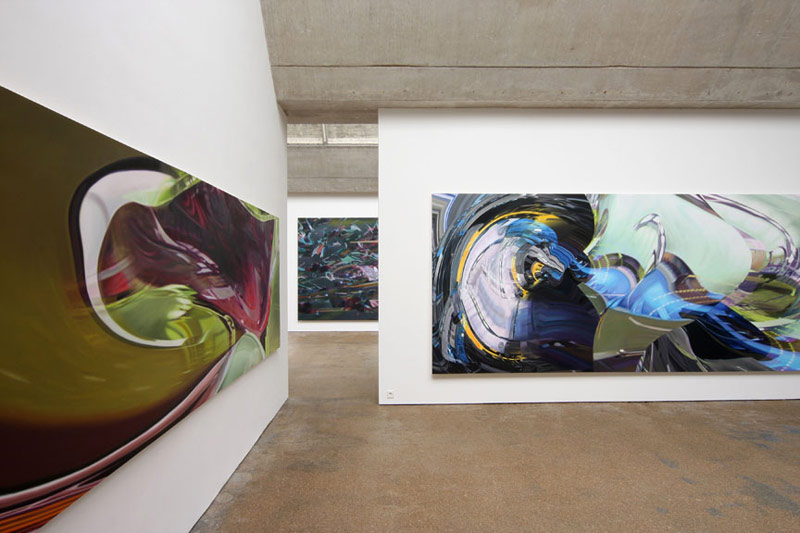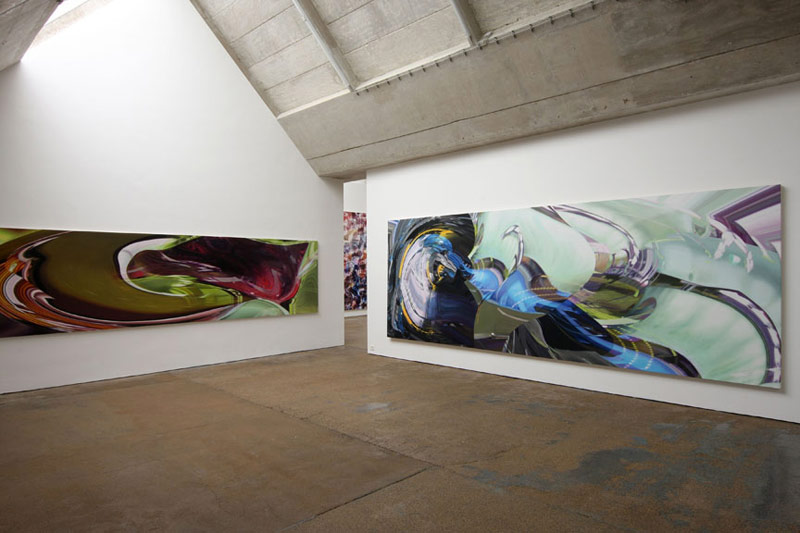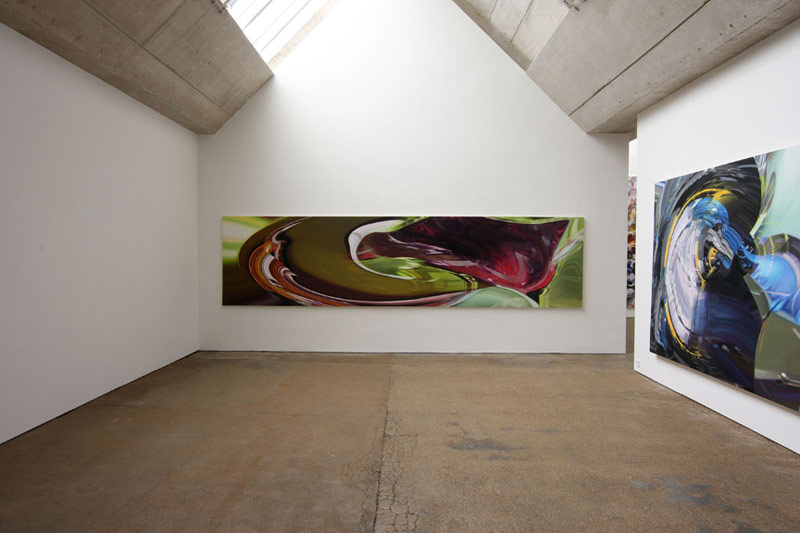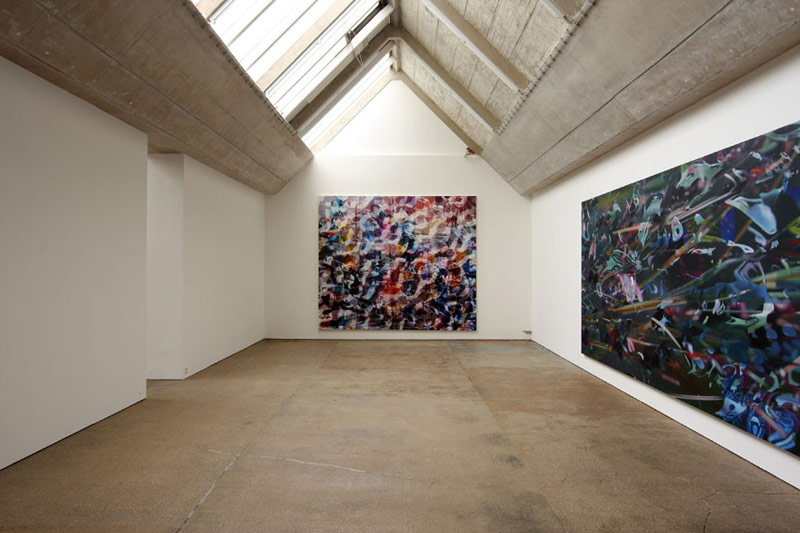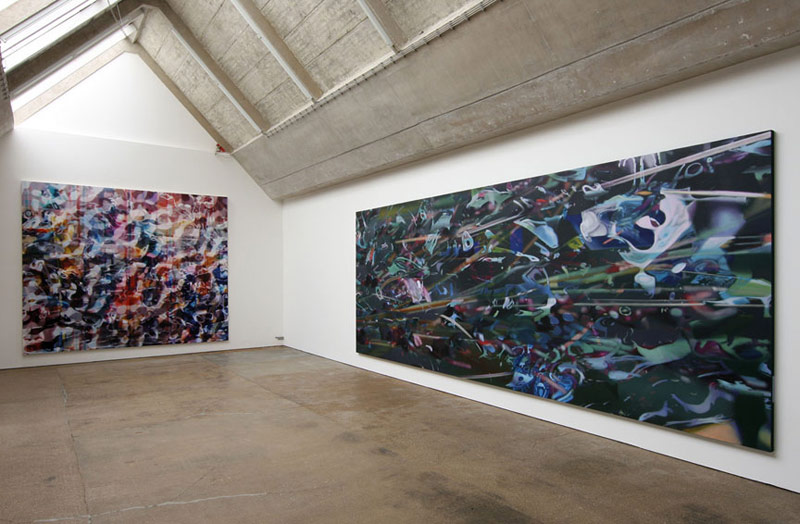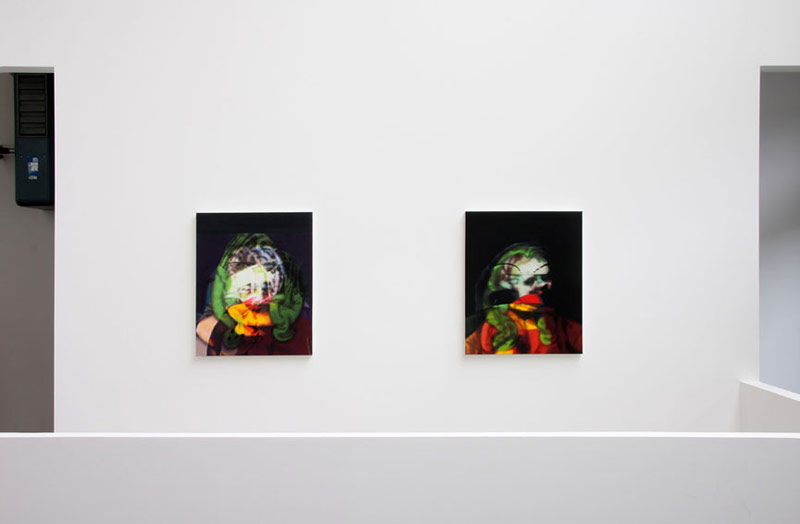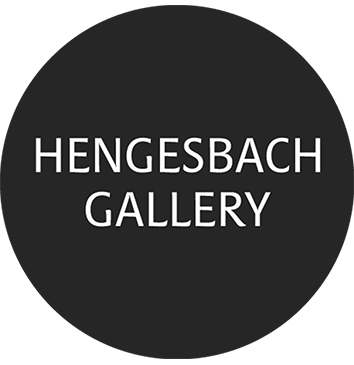Dirk Eicken – Volker Wevers
September 18 – December 19, 2009
Volker Wever’s large-format paintings oscillate between the depiction of distorted object worlds and dynamically rhythmic color spaces. They seem to transform perceptible realities into pulsating, sensuous inner or model worlds. The visible structures could be interpreted as optical distortions—like reflections on curved surfaces—of individual objects. At the same time, these figurative recognitions dissolve into gradients, color fields, or subtle shadings. Figurative interpretations quickly reach a dead end, and even abstract readings of complex image compositions remain elusive.
What resists both readings is the fact that, despite their complexity, Wever’s paintings appear seamless, as if cast in one piece. Neither the underlying reality nor the mind of a demiurge, a creator of nature who confidently conceptualized these images, is discernible. The motifs originate in scenes from the outer world—vanishing points of tree-lined streets under a sky, shop displays, or the railings of a ship. Wever uses his own photographs as source material, though his interest is neither documentary nor object-specific.
Instead, he pursues relationships that don’t arise merely from the coexistence of certain objects, but are imposed by us as observers and interpreters—from the outside: the light, the atmosphere, emotional suggestions, above all the spatial drive and kinetic impulses of a scene. Wever translates these intuitions and impressions into a playful engagement with photographic material. He treats the autonomous entities of the world as pictorial elements, placing them in mutual dependence. Everything becomes color and form. As if born from a classic painter’s palette, the painted forms exist only in relation to the choreography of the brush’s color movements.
In this view, connections and boundaries between objects are redefined. It’s comparable to juggling a variety of balls—where attention is not on the qualities of each ball, but on their trajectories and the rhythm of their converging and diverging movements. This play of motion depends solely on the gesture of the painter’s hand, on the act of bringing colors together. The arrangement of individual color zones side by side, the overarching action spaces of motion paths and lines, the emotional emphasis in their interplay and dynamic, the material constellations—none of this relates to the “balls” initially picked up.
Thanks to his painterly experience, Wever succeeds in fusing brush movements into both a pictorial composition and an inner coherence of reality. This reality dissolves isolated forms, liquefies them, and generates a sea of currents moving at varying speeds. Every object, every shape enters a state of suspension, and the entire pictorial reality articulates different states of instability in our contemporary world—one in which no Archimedean point remains. Not even ten years ago, one would have used the techniques of collage and distorted reproduction for such effects. Individual areas of an image would have been cut, shifted, displaced, color-manipulated, or distorted. Behind this playful approach, however, still stood the spirit of classical composition, maintaining the separation of individual elements across various levels. Today’s use of the computer as a compositional assistant allows for a surprising expansion of possibilities—separateness between things, units, or layers can be overcome, and entirely different elements can be fused together.
Wever compresses, stretches, reverses, accelerates sequences, and creates astonishing correlations, but without isolating elements. Instead, he keeps all currents interconnected. In his liquefied compositions, the original scene is no longer recognizable. The painter’s modeling eye has transformed it into something entirely different. The fluidity of the paint medium, when translated into large formats, becomes an inner bodily movement—a gesture of something organic. Discrete objects morph into soft, interconnected cellular structures; surfaces become currents that twist, branch, and converge—evoking bodily fluids or gradients of taste.
In merging different elements or layers, Wever builds a corporeality of expenditure, one with no precedents in reality. In modeling his forms, the painter deploys gradations, highlights, color contrasts, contours, and shifts in color volume. As viewers, we search these tonal relationships and volumes for clues to interpret object-like units and their spatial context. Our eyes instinctively ask: Do two color fields lie on the same plane, or does one arch behind the other to form a spatial connection?
Unconsciously, we always orient ourselves by how light falls on the world. It seems self-evident, yet it is only in images that we become aware of the powerful role light plays in shaping reality. Light not only animates the world—it also creates its own spatial order through its distribution and intensity, one that extends beyond mere adjacency of surfaces.
In Wever’s work, light modulation is the central element in granting his forms their unique sense of reality. Unlike today’s media images, which use believable lighting effects to lend credibility to their stylized corporeality, Wever uses light in a magical way. The light in his images resembles summoned foreign spirits—unfathomable and mysterious. Opposing these luminous apparitions is the presence of black.
Black is not merely darkness or visual inaccessibility. It is the uncanny—responsible for shadowing and defining the volume of objects, yet lacking volume itself. Its elusiveness gives it a sense of danger. The dialectic between light and dark forms a surreal foundation in Wever’s images. Neither light nor darkness is confined to specific areas in Wever’s paintings. Instead, both traverse the images in unpredictable ways, generating a unique dynamism. The wandering eye continually encounters flashes of light with a linear motion impulse—suggesting speed, even though there is no discernible bearer of that velocity. Often, light appears in the form of sharp, contoured bands contrasted with soft, blurry patches that fade into indeterminacy and reappear elsewhere. The eye intuitively connects these scattered illuminations. Thus, the light is not merely a source of illumination, but becomes an active agent engaging with the dark.
This layer is further intensified by the emotional quality of the color harmonies in the paintings. A triadic color scheme often plays a constitutive role, with Wever favoring secondary colors on his palette. These hues convey a less stable sense of certainty than primary colors; they resist categorization as purely visual or emotional phenomena and are especially sensitive to context.
As the complexity and profusion of the external world continue to grow, language still allows us to distinguish things, but our sensory systems begin to collapse under the pressure, losing the ability to separate them. In Wever’s paintings, the object-based order of the external world disappears. There is no longer any reference to individual things—color itself loses its individuality and becomes dependent on its neighbors and trajectories. The dynamic color flows drag everything into a vortex of visual sensation. Certainties are overturned. Entirely new sensual orientations emerge, and Wever’s images speak of these multifaceted speeds and their inherent instability.
Dirk Eicken’s paintings astonish viewers in several ways: they exhibit dramatic painterly coloration, yet their evenly applied color gives them the appearance of being printed. They seem to consist of multiple overlaid images, which nonetheless merge into a single visual composition of complex interstitial spaces. They contain fragments of human or vegetative figuration, yet they can just as well be read as abstract networks of painterly spaces or gestures.
Despite their distinct visual impression, Eicken’s images are created using the classical technique of oil glazing with a brush. Their luminous hues and subtly modulated color transitions are only achievable through this method. Even in areas where the color appears as a fleeting mist, as though sprayed onto the canvas, it is in fact applied with a brush. One of Eicken’s intentions is for painting not to assert itself through material presence or tangible traces, but to appear elusive—a visual illusion. Paradoxically, this avoidance of visible brushwork draws the paintings closer to photography, which likewise reveals nothing about its process of creation. Dirk Eicken is interested in the self-assertion of seeing. In his work, color is not a quality borrowed from the appearance of specific objects—it is not object-bound. Rather, color acts as a painterly impulse, tied to light and the expansion of painterly space. Color, through contour, marks the fixation of forms. Yet in Eicken’s paintings, it often remains undecidable whether a patch of color is part of a potential figure or an element of open pictorial space.
What quickly becomes clear is that these color patches do not conform to any interpretable object-related context. Their meaning does not arise from a local relationship with neighboring elements, from material stability, or from the interlocking of physical parts, but rather from an overarching compositional direction. The luminous color light radiates not only from object fragments but also from the interspaces. These interspaces enliven the entire scene—they form the supporting structure. What is usually overlooked or dismissed in our perception becomes the central event. These spaces resist objectification and cannot be interpreted in terms of concrete things.
Eicken begins with representational motifs as raw material. To prevent premature interpretation, he layers images atop one another, creating a deliberate visual confusion. While our visual curiosity might be gratified—and his painterly virtuosity flattered—when the sources of his images are revealed, this does little to enhance our understanding of the work. Ultimately, it is the eye that must navigate this open visual parcours. Through superimposition, Eicken avoids accidental focal points, aiming instead to relativize the fixed points of his source images and weave them into a new visual fabric.
He has compiled a vast archive of image sources—comprising his own photographs, found images, film stills, and reproductions from art and cultural history. He uses the computer as a compositional assistant to manipulate these sources, intervening in both their coloration and figuration before layering them. At the end of this design phase, he holds in his hands a compositional model for the final painting—one that defines the figuration and provides references for color contrasts.
Eicken’s image overlays aim to reflect the challenge of navigating today’s world. We are constantly bombarded with a multitude of images—often simultaneously—which stack up in our minds and sometimes blend together to the point of becoming indistinguishable. Eicken is not interested in flattening or simplifying this experience, but rather in intensifying it: the clash of rhythms, the varying degrees of containment and embedding of forms, the dissolution and reconstitution of visual affiliations. In the layering process, forms from different visual strata emerge into surprising juxtapositions. Depending on how the light interweaves through the layers, this superimposition can be preserved. At times, Eicken intensifies the crowded proximity so that figure and interspace alternate—flipping roles in the viewer’s perception. Other times, he maintains transparency, allowing various levels to remain visible. Through this, the figures become fragmented—they serve as building blocks for new configurations, while still alluding to their original wholeness.
A new sense of spatial openness emerges through the translation of these compositions onto canvas. Through the layering of glazed colors, the forms are imbued with the visual vitality of a singular, generative painterly gaze. What were once more graphic configurations of form are now suffused and unified by color. Like an orchestra under a single conductor, individual colors (tones) are modulated into overarching harmonies of various chromatic bodies (instruments). Sometimes, color is pure light; sometimes, it becomes an elusive body; other times, it functions as a rhythmic surface.
This process signals a departure from any consistent, object-based interpretation of our complex and confused world. The contradictions inherent in reality are transposed into contradictions of perception—where form, counterform, negative space, and planes of representation reconfigure themselves into new relationships. The forms that negate objecthood and the shifts between layers gain a penetrating force.
The painterly result is a tapestry of chromatic light rhythms, which, amid the progressive loss of tangible worldly order, simultaneously points to where something may be gained: a subjective enactment of complex appearances, offering a fleeting glimpse of what constitutes our aliveness. Yet this can only be expressed through art in the most indirect of ways.
Installation Views
